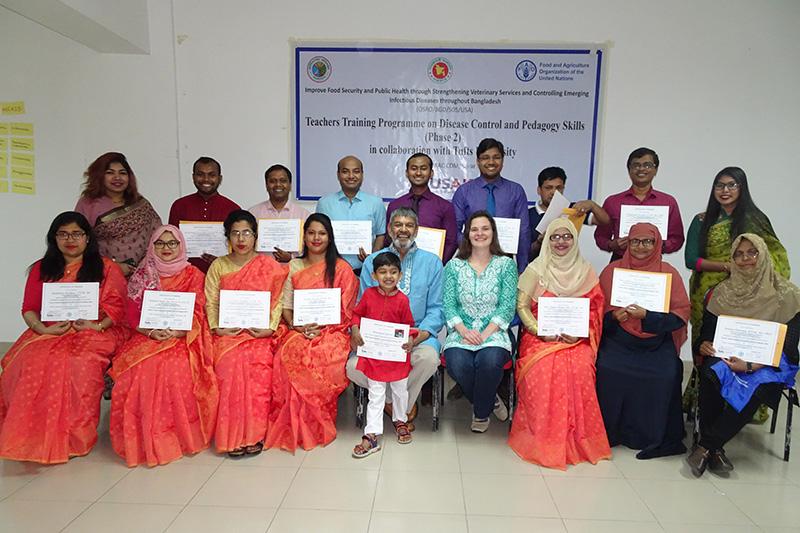-
About
- Leadership & Faculty
- News & Events
-
Academics
- Graduate
- Advanced Clinical Training
- Continuing Education
- Academic Departments
- Academic Offices
- Simulation Experiences
-
Student Life
- Offices
-
Research
-
Hospitals & Clinics
- Emergency Care
- Hospital Services
-
Community Outreach
- Volunteer
A Boost for Bangladesh
Cummings School faculty members collaborate with veterinarians in Bangladesh to combat the spread of infectious diseases

When a country’s economy relies heavily on the livestock farming industry, the effects of an infectious disease outbreak can be catastrophic, potentially killing hundreds of animals in a matter of weeks.
Hoping to prevent this type of scenario in Bangladesh, the Food and Agriculture Organization of the United Nations (FAO) has sought to improve the understanding of infectious disease control among the country’s veterinarians and boost the credibility of its veterinary schools and the profession.
In 2016, the FAO reached out to M. Sawkat Anwer, DMVH, Ph.D., emeritus/distinguished professor and associate dean for Research and Graduate Education at Cummings School. A native of Bangladesh, Dr. Anwer assembled a team of nine Cummings School faculty members to participate in the project.
The goals of the collaboration, laid out in a letter of agreement, were threefold: First, train veterinary school faculty members in the best practices for prevention and control of infectious diseases. Second, facilitate the process of accrediting veterinary schools, and third, help create a board exam for veterinarians to gain membership to the Bangladesh College of Veterinary Surgeons (BCVS) established in 2019.
Embracing Active Learning
In general, universities in Bangladesh rely on old-fashioned teaching methods, Dr. Anwer contends. “The teacher comes in, gives the lecture for an hour, and then goes away.”
To promote students’ engagement and investment, the team introduced the concept of active learning. In an exercise known as a “jigsaw puzzle,” a clinical problem—an outbreak of infectious disease among cattle, for example—was presented to a group of students, who were then divided into sub-groups. Each subgroup researched a particular aspect of the problem, such as information on the disease, how it is spread, and what established protocols will prevent the spread. “The students are involved in problem-solving, but also in gathering information,” explains Angie Warner, D.V.M., associate professor in the Department of Comparative Pathobiology. “And then they return as the expert witness in their subgroup and teach their peers.”
At one point, the teachers and students reverse roles, with the students teaching the teachers. “It was great to see the teachers step back and role play as their students and see what that experience would be like,” shares Deborah Linder, D.V.M., MS, DACVIM (nutrition), director of the Tufts Obesity Clinic for Animals. “I was impressed with the level of education and sophistication of the faculty and their enthusiastic embrace of teaching methods which was obviously very different from how they were trained.”
Dr. Anwer reports that the Bangladesh team is now training other veterinarians in the country in these methods. “They call us occasionally to ask for advice, but they are running it on their own now, which is what we wanted to see happen,” he admits.
Working toward accreditation
Using the United States’ accreditation process for veterinary schools as a model, members of the team accompanied the Bangladesh veterinarians and taught them how to administer site visits. “You see what kind of teachers and how many students they have, and the status of their teaching facilities, the lecture halls, and clinic,” explains Dr. Anwer. Each school’s faculty then performs a self-study, in which they give a grade to each one of those components.
The next step is to present the self-study to an accrediting agency, in this case the Bangladesh Veterinary Council (BVC). The BVC visits the site, provides an assessment, and makes recommendations for any improvements necessary to receive accreditation.
Dr. Warner is among the Cummings School faculty members who collaborated on this project. She has extensive experience in the United States accreditation process.
“I was privileged to join the group and visit several schools, hear their presentations, get a sense of how their education is done, tour their facilities, talk to students, and attend some classes,” Dr. Warner reports. “It was very gratifying in the sense that we were trying to do something for Bangladesh and for the veterinary profession as a whole.”
Creating the exam
Finally, the Tufts team, including Dr. Linder, helped the faculty members write a board examination. The goal was to create an exam consisting of 100 multiple-choice questions. Veterinarians who passed the test would become members of BCVS.
The teams from Tufts and Bangladesh worked together to develop a bank of 750 questions, editing and clarifying, and eventually choosing 100 questions for testing. After running a practice test, the group found a testing company in India to administer the exam in Bangladesh. Thirty-five veterinarians have taken the test so far, with 10 passing and becoming eligible to join BCVS.
Both teams consider the project a rousing success.
“After having the pedagogy training, 48 veterinary faculty members across 13 veterinary schools are now more capable, motivated, and effectively using pedagogy tools to teach veterinary students to combat newly emerging disease challenges,” says Eric Brum, D.V.M., Country Team Leader, Emergency Centre for Transboundary Animal Diseases (ECTAD), FAO Bangladesh. “The training also led directly to the formation of a teacher’s evaluation system, the first-ever in Bangladesh, that helps ensure quality teaching practices in the veterinary schools across the country.”
The nine Cummings faculty who participated in the project from 2016 to 2021 included Drs. Gillian Beamer, Nichola Hill, Erin King, Deborah Kochevar, Deborah Linder, Marieke Rosenbaum, and Jonathan Runstadler, Angie Warner and Eugene White
Department:
Dept. of Infectious Disease and Global Health